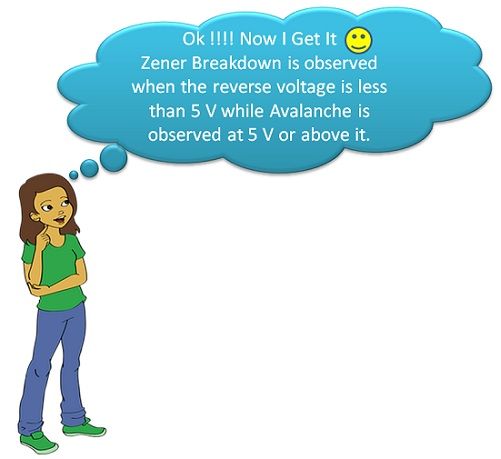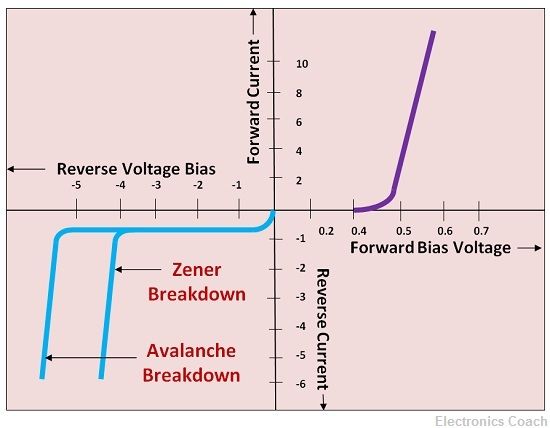The crucial difference between the Zener and Avalanche breakdown is the operating mechanism. Zener breakdown occurs when the high electric field is created across the junction. On the other hand, Avalanche Breakdown occurs in the device due to the collision of electrons moving at high speed.
In Zener breakdown, the increase in reverse voltage causes the expansion of the depletion layer. The more the width of the depletion region the more will be the electric field across the junction.
Zener breakdown occurs when the reverse voltage is less than 5 V. Avalanche breakdown occurs at the when the reverse voltage is above 5 volts. Both these breakdowns can also occur simultaneously. At 5 V it is considered that both these breakdown occurs simultaneously.

In Avalanche breakdown the minority charge carriers in the semiconductor device which move across the depletion, possess kinetic energy. The value of this kinetic energy is proportional to the applied reverse voltage. These high energy electrons collide will bounded electron and push them towards conduction band.
Content: Zener and Avalanche Breakdown
Comparison Chart
| Parameters | Zener Breakdown | Avalanche Breakdown |
|---|---|---|
| Basic Definition | It occurs when the electric field is created due to high reverese voltage. | It occurs when high velocity electrons collide with bounded electrons. |
| Reverse Voltage Range | Less than 5 V | More than 5 V |
| Doping density | High Doping density | Low doping density |
| Temperature Coefficient | Exhibit Negative temperature coefficient | Exhibit Positive temperature coefficient |
| Nature of V-I Characteristics | Very Sharp | Not as sharp as Zener Breakdown |
| Mechanism | Due to collision between electrons | Due to High electric field |
Definition of Zener Breakdown
When the reverse biased is applied to the heavily doped PN junction diode, the depletion region begins to expand. This expansion of depletion region in the diode consists of charge carriers electrons and holes. Thus, the depletion region consists of holes on one side and electron on other.
These depleted charge carriers create a strong electric field across the junction. The magnitude of the electric field generated will depend on the reverse voltage applied. The more the reverse voltage, the more will be the strength of electric field.
Thus, electric field exerts the force on the electrons present in the valence band and pulls them in higher energy band that is conduction band. In this way more and more electrons enter conduction band and contribute in the conduction process.
Therefore, the high magnitude of electric current flows in the circuit due to these electrons entering valence band. The value of current becomes excessive high that it can even lead to the breakdown of the diode. This phenomenon is called Zener Breakdown.

Definition of Avalanche Breakdown
In PN junction device the electrons when moving across the depletion region possess velocity and thus kinetic energy because kinetic energy is the products of mass and velocity of a moving body. Thus, electrons also possess kinetic energy.
These minority charge carriers randomly move in the semiconductor specimen due to the velocity they possess. These electrons, in turn, collide with other electrons which are tightly bounded to the atom due to covalent bonding.
But these electrons break the covalent bond and participate in conduction by jumping into the conduction band. This happens because high-velocity electrons which are moving in the semiconductor specimen collide with the tightly bounded electrons they impart some part of their kinetic energy to them.
Consequently, the electrons by acquiring kinetic energy start moving toward conduction band. The magnitude of kinetic energy increases with the increase in reverse voltage applied to the diode. Thus, the current starts increasing due to the collision of more and more electrons. Therefore, this high current can lead to the breakdown of the diode.
This is called Avalanche Breakdown.
Key differences Between Zener and Avalanche Breakdown
- The significant difference between Zener and Avalanche breakdown is the doping characteristics. Zener Breakdown occurs in the diodes which are heavily doped while Avalanche breakdown occurs in the diode which is lightly doped.
- The temperature coefficient of Zener and Avalanche breakdown is different. The Zener breakdown voltage varies inversely with the temperature while Avalanche breakdown voltage varies directly with the temperature. Thus, the temperature coefficient of Zener breakdown is negative while temperature coefficient of Avalanche breakdown is positive.
- The operating voltage also creates a major difference between Zener and Avalanche breakdown. Zener breakdown is observed when the voltage is less than 5V, and Avalanche breakdown is observed when the voltage is more than 5V.
- The movement of the valence band and conduction band also creates a key difference between Zener and Avalanche breakdown. The valence band gets pushed towards conduction band in case of Avalanche breakdown due to energy imparted to electrons as a result of the collision between them.
- In Zener breakdown, the electrons in the valence band are pulled towards conduction band due to high magnitude of the electric field generated across the junction.
- The V-I Characteristics of Zener and Avalanche breakdown are also different. The curve of Zener breakdown is very sharp while the curve of Avalanche breakdown is not as sharp.

Conclusion
The Avalanche breakdown occurs when electrons collide with other electrons and make them flow in conduction band while Zener Breakdown occurs due to the high electric field. The intensity of electric field is high that is about 3 * 107 V/m.
The breakdown of the circuit can be prevented with the help of resistor connected in series with the circuit and limiting the current through the circuit. The breakdown mechanism is harmless till we successfully maintain the operating temperature.
The junction voltage in Zener breakdown starts reducing with the increment in the temperature while the avalanche breakdown starts increasing with the increment in temperature. Thus, to minimize the effects of Breakdown, the safe operating temperature should be maintained.
Leave a Reply